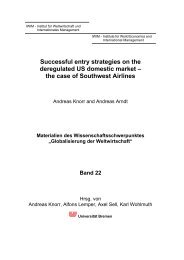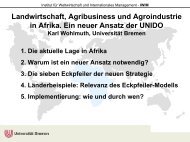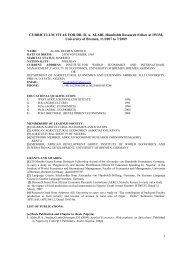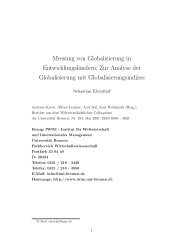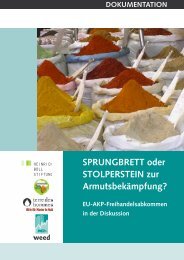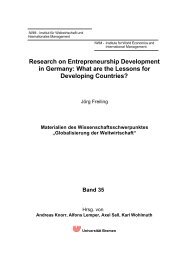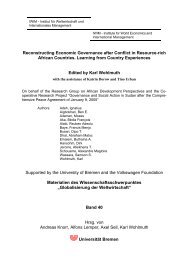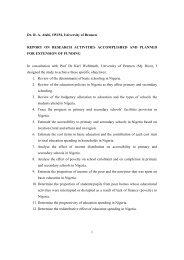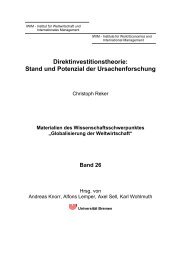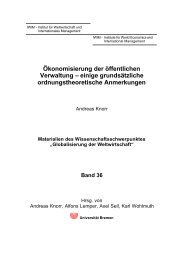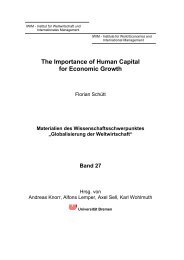Sectoral Analysis of Impact of Foreign Aid in Nigeria - Institute for ...
Sectoral Analysis of Impact of Foreign Aid in Nigeria - Institute for ...
Sectoral Analysis of Impact of Foreign Aid in Nigeria - Institute for ...
You also want an ePaper? Increase the reach of your titles
YUMPU automatically turns print PDFs into web optimized ePapers that Google loves.
5<br />
The rest <strong>of</strong> the proposal is divided <strong>in</strong>to five sections. The <strong>in</strong>troduction above is<br />
followed by the objectives <strong>of</strong> the study <strong>in</strong> Section two; Section three justifies the importance<br />
<strong>of</strong> <strong>for</strong>eign aid and the study <strong>in</strong> the context <strong>of</strong> <strong>Nigeria</strong>. Section four reviews the literature on<br />
effectiveness <strong>of</strong> <strong>for</strong>eign aid, section five deals with econometric techniques proposed to be<br />
used to undertake the study, while section six presents the policy implications <strong>of</strong> the study.<br />
2.0 Objective <strong>of</strong> the Study<br />
The study will analyse the impact <strong>of</strong> <strong>for</strong>eign aid on different sectors <strong>of</strong> <strong>Nigeria</strong>n<br />
economy. Specifically,<br />
(i) The study will test the causality between <strong>for</strong>eign aid (bilateral and multilateral) and<br />
economic growth <strong>in</strong> <strong>Nigeria</strong>.<br />
(ii) It will determ<strong>in</strong>e the impact <strong>of</strong> <strong>for</strong>eign on critical sectors <strong>of</strong> the economy such as<br />
agriculture, manufactur<strong>in</strong>g, education and health.<br />
(iii) Make policy recommendation on sectoral <strong>for</strong>eign aid adm<strong>in</strong>istration <strong>in</strong> <strong>Nigeria</strong>.<br />
3.0 Justification <strong>for</strong> <strong>Foreign</strong> <strong>Aid</strong> and the Study<br />
Four decades after Independence <strong>in</strong> 1960, <strong>Nigeria</strong> rema<strong>in</strong>s a poor country with a per<br />
capita <strong>in</strong>come <strong>of</strong> US$260 <strong>in</strong> 2000. At the dawn <strong>of</strong> the Third Millennium, approximately 70%<br />
<strong>of</strong> the population still lived on less than US$1 a day (about 84 million people), an <strong>in</strong>dication<br />
<strong>of</strong> extreme poverty. Real GDP growth has rema<strong>in</strong>ed sluggish, averag<strong>in</strong>g 3.5% per annum<br />
s<strong>in</strong>ce 2000. It requires an annual GDP growth rate <strong>of</strong> 7-8% <strong>in</strong> order to halve the number <strong>of</strong><br />
people <strong>in</strong> poverty by 2015, and this translates to an <strong>in</strong>vestment rate <strong>of</strong> more than 30% per<br />
annum. In addition, the country faces daunt<strong>in</strong>g challenges <strong>of</strong> re-build<strong>in</strong>g a country badly<br />
damaged by decades <strong>of</strong> military misrule and a fragile democracy. There is tremendous<br />
pressure on the government to deliver some ‘democracy dividends’. Furthermore, there are<br />
the threats <strong>of</strong> preventable diseases such as malaria, HIV/AIDS, and Tuberculosis (Iyoha,<br />
2005). <strong>Nigeria</strong> is also a highly <strong>in</strong>debted country with total external debt exceed<strong>in</strong>g US$32<br />
billion <strong>in</strong> 2003 6 . The debt service burden rema<strong>in</strong>s crush<strong>in</strong>g 7 . <strong>Foreign</strong> aid <strong>in</strong> the <strong>for</strong>m <strong>of</strong><br />
6 In the 1980s, largely as a result <strong>of</strong> fall<strong>in</strong>g oil export earn<strong>in</strong>gs, <strong>Nigeria</strong>’s external debt rapidly escalated. Her<br />
external debt stock amounted to a mere US$985 million <strong>in</strong> 1977, from there <strong>Nigeria</strong> became one <strong>of</strong> the most<br />
heavily <strong>in</strong>debted countries <strong>in</strong> sub- Saharan Africa, with total external debt peak<strong>in</strong>g at over US$30.0 billion <strong>in</strong><br />
1991. In 1993, <strong>Nigeria</strong>’s per capita external debt amounted to US$300, which was roughly equal to its <strong>in</strong>come<br />
per capita. Accompany<strong>in</strong>g the escalat<strong>in</strong>g external debt has been a crush<strong>in</strong>g debt-service burden. After peak<strong>in</strong>g<br />
at 42 percent <strong>in</strong> 1986, the actual debt-service ratio (the ratio <strong>of</strong> actual debt service payments to export earn<strong>in</strong>gs)<br />
has s<strong>in</strong>ce fluctuated between 24% and 29%. A direct consequence <strong>of</strong> the escalat<strong>in</strong>g debt and high debt-service



